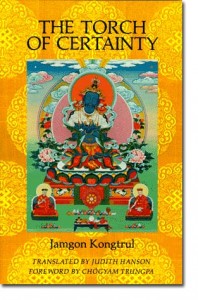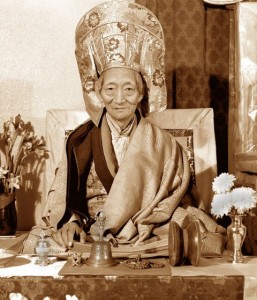
The book “Torch of Certainty“, first published by Shambhala in 1977, has become a classic reference material in the English speaking world for all using the Four Foundational Practices (Tib. Ngöndro) of Tibetan Buddhism, especially as taught in the Karma Kagyu school. It is a translation of a text by Jamgon Kongtrul Lodrö Thaye (1813-1899), entitled “The Torch of True Meaning”, which is in turn based on the 9th Karmapa Wangchuk Dorje’s (1556–1603) treatise on the Great Seal (Skt. Mahamudra) entitled “The Ocean of True Meaning”. While the English translation, made in the early days of Tibetan Buddhism’s introduction to the West in the 1970’s now sounds somewhat dated, the book is excellent, and the introduction contains questions and answers about the Four Foundational Practices with three influential lamas who were alive and active in the West when the book was published; Trungpa Rinpoche (1939-1987), Deshung Rinpoche (1906-1987) and Kalu Rinpoche (1905-1989).
In the introducation to the book, Kalu Rinpoche – one of the first teachers of Hannah and Lama Ole Nydahl – summarises the Ngöndro as follows: “Generally speaking, the first practices (refuge and prostrations, Vajrasattva and mandala offering) clear away obscurations and gather the two accumulations. The guru yoga gives you great faith in your guru which leads to your receipt of his blessing and attainment of mahamudra”.
Two important questions which Kalu Rinpoche addresses in the book’s introduction are:
In what ways, if any, will the manner of practising the Foundations here in the West differ from that follwed in Tibet? Will Westerners find the Foundations easier or more difficult to practice?
KALU RINPOCHE: The way of practicing the Foundations will be basically the same here as it was in Tibet. In Tibet there were people; here there are people. In Tibet they had defilements; here they have defilements. However, Westerners do seem to have the additional problem of doubt, of unwillingness to accept the validity of the teachings. This stems from your superior education in worldly matters. On the positive side, Westerners can learn the Dharma very quickly as compared to the length of time it took Tibetans to learn it.
Is it possible to reach full enlightenment simply by practicing these Four Foundations?
KALU RINPOCHE: Yes. In order to become a perfect Buddha, one must develop compassion. In this set of practices, compassion is developed by doing prostrations accompanied by engenderment of the enlightened attitude and the Four Immeasurables.
To become a perfect Buddha one must also understand emptiness. In each practice, the objects of meditation [i.e., the sources of refuge and so on] become inseperable from the meditator, and then the meditator lets his mind rest natuarally. These are the profound means for realizing emptiness and Mahamudra.
The development of compassion and the realization of emptiness are the two requirements for achieving enlightenment. During the Four Foundation practices – particularly in Taking Refuge and Engendering the Enlightened Attitude and in the Guru-Yoga – these two are integrated.
Other posts which may be of interest :
Tags: 9th Karmapa, Four Foundational Practices, Jamgon Kongtrul Lodro Thaye, Kalu Rinpoche, Ngondro, Torch of Certainty, Wangchuk Dorje




 Follow
Follow
You folks consistently come up with so much interesting stuff in the blog – brilliant!!!!
thanks to all and keep it coming :-)
Best wishes – Mike
Thank you, much needed!